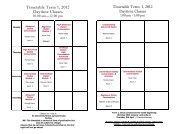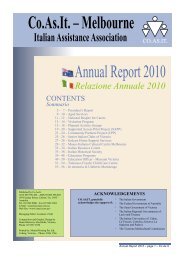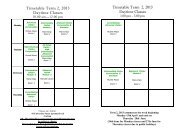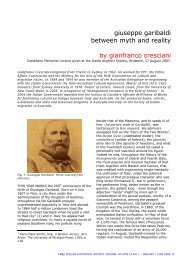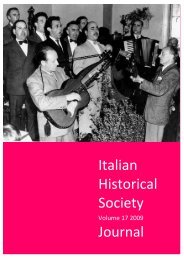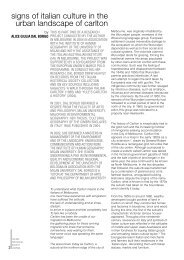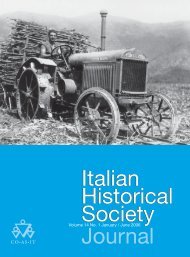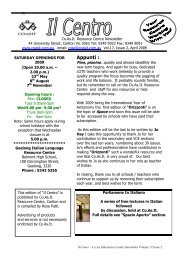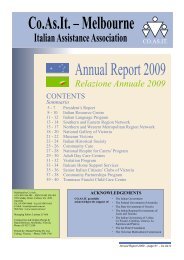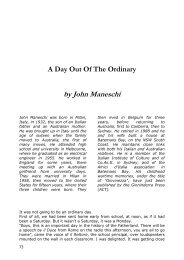January-December 2010, vol. 1
January-December 2010, vol. 1
January-December 2010, vol. 1
- No tags were found...
You also want an ePaper? Increase the reach of your titles
YUMPU automatically turns print PDFs into web optimized ePapers that Google loves.
My dad was a character almost too big to be contained by rulesor cultural tradition, a Belzoni 5 of a man with hands the size ofdinner plates, a booming voice, and an appetite for life thatmatched his appetite for pasta al pomodoro. Australia in the1950s was made for someone like my dad.My mother, Giuseppina Vertovec, was born in the village ofGabrije, San Daniele del Carso, in 1930 and she grew up inTrieste. In the late 1940s, she represented Trieste in atleticaleggera as a runner and high-jumper. In 1950 she wascampionessa di salto in alto. Mum was the youngest of threesisters, one of whom had migrated to Australia in 1956. In 1959,at the age of 29, my mother boarded the Flaminia and alsomigrated to Australia, living in Melbourne with her sister'sfamily and working as a sewing machinist. Sometime in theearly 1960s, perhaps 1964, my mum returned to Trieste to helpher eldest sister who had fallen ill after the birth of her secondchild. Mum's original intention was to stay in Italy, but for somereason, she decided that her life lay in Australia. Either late in1964, or early in 1965, Mum boarded the Galileo Galilei and setoff for Australia again.Several objects which have survived from this part of mymother's life speak much about her hopes for the future. Herbeautifully embroidered biancheria, painstakingly created andcarefully preserved over the years, are in themselves works ofart. I can imagine the three sisters sitting together in Trieste,stitching their dreams for domestic bliss into these pieces offabric. A well-used tablecloth became a particularly potentcontainer of memory for my mother – the embroideredpoppies, cornflowers, margherita daisies and sprigs of goldenhay grass all evoked her homeland. She always said it was goodluck to keep some cut hay grass in the house, a symbol offertility and a good omen for a rich harvest.of 1950s design and tastes. This dilapidated <strong>vol</strong>ume speaks ofyears of constant use in Mum's various Australian kitchens.Many of my memories of Mum in<strong>vol</strong>ve food. In the 1970s,when I was very little, we would go on long expeditions throughthe suburbs of Sydney in search of Italian food products. Iremember a shop in Sydney's Haymarket area calledGavagna's. It was a dark Aladdin's cave of strange smells whereI could run my small hands through vast hessian sacks ofhazelnuts in their hard shiny shells and peer at the 1950spostcards of Italy pinned to the walls. The area where Gavagnaonce plied his wares is now near the heart of Sydney'sChinatown, the Italian presence now silenced, usurped by Asiangrocery stores and hoards of hip young university students.Mum's athletics medals from the late 1940s and early 1950s tellof the prowess and vitality of her youth. They are testament tothe importance that Italy placed on sport as a means ofrebuilding a sense of national pride after the devastation ofWorld War Two, especially when it came to capturing theinterest of the younger generation. This certainly affected mymum as exemplified by her sense of patriotism towards Italyand her hometown of Trieste until her death. The medals havea wonderful tactile quality. The strong athletic figures modelledin low relief, stretch, leap, and stride forth to conquer all.Several show the Basilica of San Giusto, the enduring symbol ofthe city of Trieste. Mum kept her medals in a slightly batteredold tin, nestled in a crumpled paper serviette.Fig 7. Athletic medals won by Giuseppina Maniero (nee Vertovec) inTrieste.Fig 6. Tablecloth embroidered by Giuseppina Maniero (nee Vertovec),c.1950sAn essential part of her equipment for her new life in Australiawas an Italian cookbook, Il Cucchiaio d'argento, a time capsule5 Giovanni Belzoni (1778-1823) was an Italian strongman, inventor andadventure traveller, famed for his exploits in Egypt during the early1800s when he helped remove many grand antiquities and transportthem to the British Museum. He was the first European to penetratethe second pyramid at Giza and his huge graffiti, scoperta da G. Belzoni,can be seen in the burial chamber. Like my dad, he was a native ofPadua. (Source: Wikipedia)In 1959, when my mother left Trieste the first time, she wasgiven a brooch displaying the profile of a young woman. It is ahaunting image – the young woman’s eyes are covered with ablindfold and she seems to have to rely on intuition or trust toguide her. My mum had a favourite saying, fino alla morte nonsi sa la sorte (until death you don't know what your destiny willbe), and the events of her own life proved over and over againthat the saying was indeed true. Unlike my dad, whose sisterconsigned him to God, Mum was placed in the hands of blinddestiny, and destiny had a big surprise in store for my mumwhen she left Trieste for the second time.22 | IHSJ ITALIAN HISTORICAL SOCIETY JOURNAL VOLUME 18 <strong>2010</strong>



